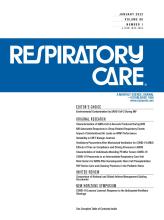This article requires a subscription to view the full text. If you have a subscription you may use the login form below to view the article. Access to this article can also be purchased.
Abstract
BACKGROUND: Noninvasive ventilation (NIV) is the reference standard treatment for most situations of chronic respiratory failure. NIV settings must be titrated to both preserve upper-airway patency and control hypoventilation. Automatic adjustment of pressure support (PS) and expiratory positive airway pressure (EPAP) may facilitate the initiation and follow-up of domiciliary NIV. However, whether the automatic-adjustment algorithms embedded into current devices accurately detect, respond to, and score common sleep-related respiratory events remains unclear.
METHODS: A bench was set up to simulate central hypopnea (CH), central apnea (CA), obstructive hypopnea (OH), and obstructive apnea (OA). Four home ventilators were evaluated, with their dedicated modes for automatic PS and EPAP adjustment.
RESULTS: All 4 devices increased PS during CH, CA, and OH. However, PS adjustment varied widely in magnitude, with tidal volumes within 100 ± 20% of the target being provided by only 3 devices for CH, one for CA, and one for OH. Two devices increased EPAP for OH and 3 for OA, including one that also increased EPAP for CA. Only 2 devices scored residual hypopnea after simulated CA, and only one scored a residual event after OH. One device scored no event.
CONCLUSIONS: Current NIV devices differed markedly in their responses to, and reporting of, standardized sleep-related respiratory events. Further improvements in embedded NIV algorithms are needed to allow more widespread out-of-laboratory initiation and follow-up of NIV.
- automated algorithms
- bench study
- chronic respiratory failure
- noninvasive ventilation
- sleep-related respiratory events
Footnotes
- Correspondence: Mathieu Delorme PT MSc, Equipe de Recherche sur le Handicap Neuromoteur (ERPHAN), Pavillon Colbert, Porte 102, Hôpital Raymond Poincaré, 104 Boulevard Raymond Poincaré, 92380 Garches, France. E-mail: mathieu.delorme.pt{at}gmail.com
Mr Delorme discloses relationships with Air Liquide Medical Systems, Breas Medical, ResMed, and L3 Medical. Dr Leotard discloses relationships Air Liquide Medical Systems. The remaining authors have disclosed no conflicts of interest.
The devices studied were supplied by ASV Santé, a home care provider involved in the conducting of the current study.
Drs Lofaso and Louis are co-senior authors.
Supplementary material related to this paper is available at http://www.rcjournal.com.
- Copyright © 2023 by Daedalus Enterprises
Pay Per Article - You may access this article (from the computer you are currently using) for 1 day for US$30.00
Regain Access - You can regain access to a recent Pay per Article purchase if your access period has not yet expired.











